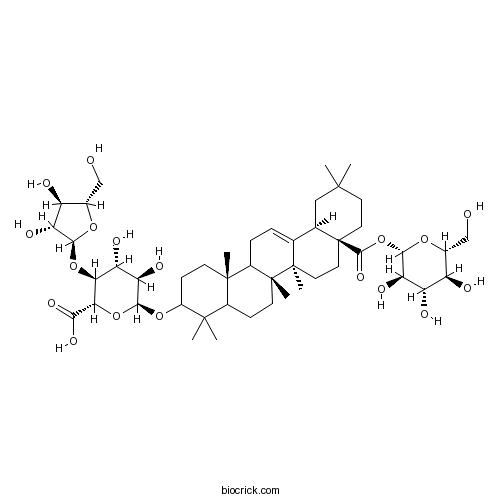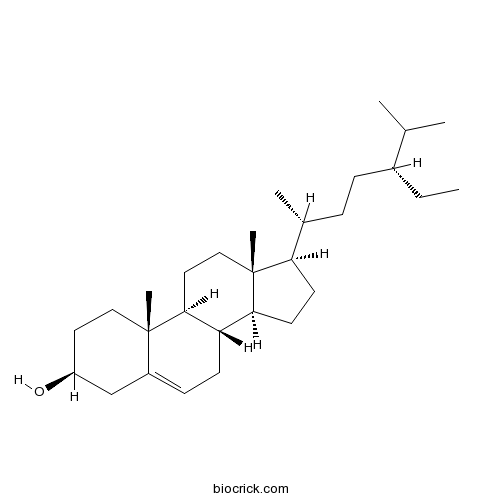Aralia chinensis
Aralia chinensis
1. The products in our compound library are selected from thousands of unique natural products; 2. It has the characteristics of diverse structure, diverse sources and wide coverage of activities; 3. Provide information on the activity of products from major journals, patents and research reports around the world, providing theoretical direction and research basis for further research and screening; 4. Free combination according to the type, source, target and disease of natural product; 5. The compound powder is placed in a covered tube and then discharged into a 10 x 10 cryostat; 6. Transport in ice pack or dry ice pack. Please store it at -20 °C as soon as possible after receiving the product, and use it as soon as possible after opening.
Natural products/compounds from Aralia chinensis
- Cat.No. Product Name CAS Number COA
-
BCN2683
Chikusetsusaponin IV7518-22-1
Instructions

-
BCN1015
Beta-Sitosterol83-46-5
Instructions

Elatoside C protects against ox-LDL-induced HUVECs injury by FoxO1-mediated autophagy induction.[Pubmed: 28189723]
The vascular endothelial cell injury induced by oxidized low-density lipoprotein (ox-LDL) is a major contributing factor to the pathogenesis of atherosclerosis. Elatoside C (EsC), a natural saponin isolated from Longya Aralia chinensis L., possesses anti-oxidative activity; however, there is still no report indicating that EsC protects against ox-LDL-induced endothelial cell injury and the exact mechanisms of this protection. Recently, autophagy has attracted extensive attention on the basis of its ability to modulate cell survival. Thus, we determined the role of autophagy in the protective effects of EsC against ox-LDL-induced human umbilical vein endothelial cells (HUVECs). Our results demonstrated that EsC pretreatment reduced ox-LDL-induced HUVECs oxidative injury, increased the number of autophagosomes and modulated the expression of autophagy related proteins. Moreover, autophagy inhibitor 3-methyladenine, chloroquine and BECN1 siRNA obviously abolished the anti-oxidative effects of EsC. Furthermore, our data indicated that EsC significantly increased nuclear FoxO1 expression level and FoxO1 siRNA markedly attenuated the protective effects of EsC. In conclusion, EsC attenuated ox-LDL-induced HUVECs injury by inducing autophagy via increasing FoxO1 expression level. EsC is thus considered as a potential drug for the treatment of atherosclerosis.
Six New Triterpene Derivatives from Aralia chinensis Var. dasyphylloides.[Pubmed: 27941689]
None
Total aralosides of aralia elata (Miq) seem (TASAES) ameliorate nonalcoholic steatohepatitis by modulating IRE1α-mediated JNK and NF-κB pathways in ApoE-/- mice.[Pubmed: 25655997]
Total saponins of Aralia elata (Miq) Seem (TASAES) from the Chinese traditional herb Long ya Aralia chinensis L. is popularly used as a folk medicine to treat rheumatism, neurasthenia, diabetes, hepatitis and antivirus in Asian countries. However, there was poor study of TASAES on Non-alcoholic steatohepatitis (NASH), which is characterized by inflammatory responses and hepatocellular apoptosis exacerbating liver injury. This study aimed to clarify whether or not the anti-inflammatory and anti-apoptotic activities and protective mechanisms of the total aralosides of Aralia elata (Miq) Seem (TASAES) ameliorate NASH in a high-fat diet (HFD)-induced ApoE-/- mouse model.
Effect of the total saponins of Aralia elata (Miq) Seem on cardiac contractile function and intracellular calcium cycling regulation.[Pubmed: 24875646]
Total saponins of Aralia elata (Miq) Seem (AS) from the Chinese traditional herb Longya Aralia chinensis L. can improve cardiac function, although the active mechanism remains poorly understood. The present study aimed to determine the direct effect of AS on cardiac function in dogs and the effects on Ca2+ transient and contractions in isolated rat cardiomyocytes.
Apoptosis-induced cell death due to oleanolic acid in HaCaT keratinocyte cells--a proof-of-principle approach for chemopreventive drug development.[Pubmed: 22901164]
Oleanolic acid (OA) is a naturally occurring triterpenoid in food materials and is a component of the leaves and roots of Olea europaea, Viscum album L., Aralia chinensis L. and more than 120 other plant species. There are several reports validating its antitumor activity against different cancer cells apart from its hepatoprotective activity. However, antitumor activity against skin cancer has not been studied well thus far. Hence the present study of effects of OA against HaCaT (immortalized keratinocyte) cells--a cell-based epithelial model system for toxicity/ethnopharmacology-based studies--was conducted. Radical scavenging activity (DPPH·) and FRAP were determined spectrophotometrically. Proliferation was assessed by XTT assay at 24, 48 and 72 hrs with exposure to various concentrations (12.5-200 μM) of OA. Apoptotic induction potential of OA was demonstrated using a cellular DNA fragmentation ELISA method. Morphological studies were also carried out to elucidate its antitumor potential. The results revealed that OA induces apoptosis by altering cellular morphology as well as DNA integrity in HaCaT cells in a dose-dependent manner, with comparatively low cytotoxicity. The moderate toxicity observed in HaCaT cells, with induction of apoptosis, possibly suggests greater involvement of programmed-cell death-mediated mechanisms. We conclude that OA has relatively low toxicity and has the potential to induce apoptosis in HaCaT cells and hence provides a substantial and sound scientific basis for further validation studies.
Protective effect of total aralosides of Aralia elata (Miq) Seem (TASAES) against diabetic cardiomyopathy in rats during the early stage, and possible mechanisms.[Pubmed: 19381071]
Total aralosides of Aralia elata (Miq) Seem (TASAES) from Chinese traditional herb Longya Aralia chinensis L was found to improve cardiac function. The present study was to determine the protective effects of TASAES on diabetic cardiomyopathy, and the possible mechanisms. Therefore, a single dose of streptozotocin was used to induce diabetes in Wister rats. Diabetic rats were immediately treated with low, medium and high doses of TASAES at 4.9, 9.8 mg/kg and 19.6 mg/kg body weight by gavage, respectively, for eight weeks. Cardiac function was evaluated by in situ hemodynamic measurements, and patch clamp for the L-type Ca2+ channel current I(Ca(2+)-L) and transient outward K+ channel current (I(to)). Histopathological changes were observed under light and electron microscope. The expression of pro-fibrotic factor, connective tissue growth factor (CTGF) was monitored using immunohistochemistry staining. Compared with diabetic group, medium and high doses, but not low dose, of TASAES showed a significant protection against diabetes-induced cardiac dysfunction, shown by increased absolute value of left ventricular systolic pressure (LVSP) and maximum rates of pressure development (+/-dp/dt(max)), and enhanced amplitude of I(Ca(2+)-L) (P<0.05). Histological staining indicated a significant inhibition of diabetes-caused pathological changes and up-regulation of CTGF expression (P< 0.05). The results suggest that TASAES prevents diabetes-induced cardiac dysfunction and pathological damage through up-regulating I(Ca(2+)-L) in cardiac cells and decreasing CTGF expression.


